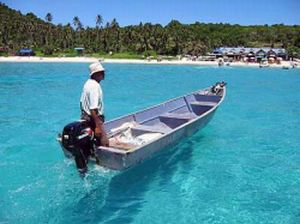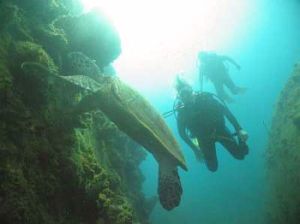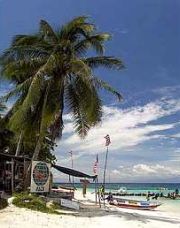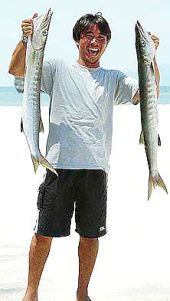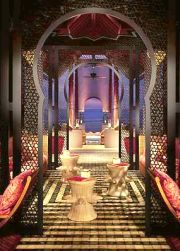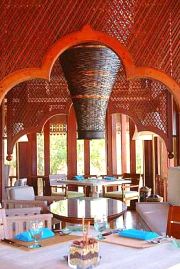Koh Samui’s lesser-known sister
Thursday September 14, 2006
By Kamaruzaman Yaacob
The resort island of Pulau Perhentian off Tereng-ganu's coast shares geographical similarities with its Thai counterpart of Koh Samui, situated 600km to the north. But it still lags when it comes to drawing tourists.
Tourism operators on the island are of the opinion that networking with their counterparts in Koh Samui can help bring the much needed tourists.
The Thailand Tourism Association's Deputy Chairman Abdul Aziz Awang Seman also opined that tour operators in Malaysia must take steps to promote Pulau Perhentian in Thailand as no information was available on the island there.
“Everyday, almost 12,000 international tourists visit Koh Samui and some of them want to continue their vacation to other places,” he said.
Abdul Aziz said for the benefit of both islands, he was trying to establish a networking between tour operators in Koh Samui and Pulau Perhentian.
Pulau Perhentian is made of a cluster of islands consisting of Pulau Perhentian Besar, Pulau Perhentian Kecil, Pulau Susu Dara and a few other small islands covering 1,392ha.
It has been gazetted as a marine park.
The tourist attractions are in Pulau Perhentian Besar along Teluk Pauh, Pasir Jong, Teluk Keke and Teluk Dalam. Meanwhile the attractions on Pulau Perhentian Kecil lies at Kampung Pasir Panjang and Teluk Kerma.
Dominic Johnson, 20, a tourist from England when met at Pulau Perhentian said the attractions were similar to Koh Samui.
“Here, the situation is quiet and refreshing compared to Koh Samui which is always filled with tourists and traffic congestion.
“Here, we are free to engage in varied activities like scuba diving, snorkelling and jungle trekking. The natural surroundings are also untouched, while over there, it's cramped with rapid development,” he said.
However, there are some impediments in bringing tourists from Koh Samui.
Obviously more needs to be done to draw tourists to the island despite its having natural beauty and crystal clear waters.
Firstly there are no direct ferry services or flights from Koh Samui to the island or even to the nearest town in the mainland as pointed out by Abdul Aziz who is also a member of the Thailand Tourism Board.
Because of this, tourists from Koh Samui must travel back to Bangkok to take a flight to Kuala Lumpur before continuing to Pulau Perhentian.
The other option is a RM180 van ride that takes eight hours to reach Besut and then board a ferry to the island at a cost of RM30 for a one-way trip.
Secondly the facilities and infrastructure even for the in-habitants are limited, and at any one time the most it can only cater for fewer than 3,000 visitors.
According to the local head in Pulau Perhentian Kecil, Che Omar Che Mat, 57, there are currently a bazaar, a primary school, a midwife clinic and a police station under construction.
More importantly the island needs clean fresh water and Che Omar hoped the government would speed up the building of a pipeline from the mainland to bring clean water.
Thirdly and probably the most critical impediment concerns the coral reefs, which are among the best in the region. But these tourism assets for the island, are fast vanishing.
The coral reefs especially at Pantai Teluk Dalam, on the eastern part of the island, were seen to be facing extermination due to the receding water level.
During low tides, the dead corals are washed ashore along the 3km-long beach, creating an ugly beachfront with the sight best described by Dutch tourist Romano Ruis, 23, as disappointing.
“The authorities must take action to overcome the problem before it's too late,” he said.
For the owner of Arwana Resort Datuk Abdul Aziz Mat Daud, the coral reefs around the area have long been dead and it's hard to revive them again.
Efforts should be taken to deepen the area though it may incur huge cost.
“Similar efforts in the Caribbean islands helped to produce a new marine park.
“The dead reefs were dug out and made into a fortress in the water. In long term, a man-made lagoon and marine park was created,” he said.
About 95% of the 1,500 villagers in Pulau Perhentian Kecil are now active in the tourism industry around Pulau Perhentian Besar.
Here, there are about, 40 resorts and chalets providing job opportunities to 600 people.
Despite the limitations, Pulau Perhentian is still a worthwhile destination for any nature lover. – Bernama / Star.
Thursday September 14, 2006
By Kamaruzaman Yaacob
The resort island of Pulau Perhentian off Tereng-ganu's coast shares geographical similarities with its Thai counterpart of Koh Samui, situated 600km to the north. But it still lags when it comes to drawing tourists.
Tourism operators on the island are of the opinion that networking with their counterparts in Koh Samui can help bring the much needed tourists.
The Thailand Tourism Association's Deputy Chairman Abdul Aziz Awang Seman also opined that tour operators in Malaysia must take steps to promote Pulau Perhentian in Thailand as no information was available on the island there.
“Everyday, almost 12,000 international tourists visit Koh Samui and some of them want to continue their vacation to other places,” he said.
Abdul Aziz said for the benefit of both islands, he was trying to establish a networking between tour operators in Koh Samui and Pulau Perhentian.
Pulau Perhentian is made of a cluster of islands consisting of Pulau Perhentian Besar, Pulau Perhentian Kecil, Pulau Susu Dara and a few other small islands covering 1,392ha.
It has been gazetted as a marine park.
The tourist attractions are in Pulau Perhentian Besar along Teluk Pauh, Pasir Jong, Teluk Keke and Teluk Dalam. Meanwhile the attractions on Pulau Perhentian Kecil lies at Kampung Pasir Panjang and Teluk Kerma.
Dominic Johnson, 20, a tourist from England when met at Pulau Perhentian said the attractions were similar to Koh Samui.
“Here, the situation is quiet and refreshing compared to Koh Samui which is always filled with tourists and traffic congestion.
“Here, we are free to engage in varied activities like scuba diving, snorkelling and jungle trekking. The natural surroundings are also untouched, while over there, it's cramped with rapid development,” he said.
However, there are some impediments in bringing tourists from Koh Samui.
Obviously more needs to be done to draw tourists to the island despite its having natural beauty and crystal clear waters.
Firstly there are no direct ferry services or flights from Koh Samui to the island or even to the nearest town in the mainland as pointed out by Abdul Aziz who is also a member of the Thailand Tourism Board.
Because of this, tourists from Koh Samui must travel back to Bangkok to take a flight to Kuala Lumpur before continuing to Pulau Perhentian.
The other option is a RM180 van ride that takes eight hours to reach Besut and then board a ferry to the island at a cost of RM30 for a one-way trip.
Secondly the facilities and infrastructure even for the in-habitants are limited, and at any one time the most it can only cater for fewer than 3,000 visitors.
According to the local head in Pulau Perhentian Kecil, Che Omar Che Mat, 57, there are currently a bazaar, a primary school, a midwife clinic and a police station under construction.
More importantly the island needs clean fresh water and Che Omar hoped the government would speed up the building of a pipeline from the mainland to bring clean water.
Thirdly and probably the most critical impediment concerns the coral reefs, which are among the best in the region. But these tourism assets for the island, are fast vanishing.
The coral reefs especially at Pantai Teluk Dalam, on the eastern part of the island, were seen to be facing extermination due to the receding water level.
During low tides, the dead corals are washed ashore along the 3km-long beach, creating an ugly beachfront with the sight best described by Dutch tourist Romano Ruis, 23, as disappointing.
“The authorities must take action to overcome the problem before it's too late,” he said.
For the owner of Arwana Resort Datuk Abdul Aziz Mat Daud, the coral reefs around the area have long been dead and it's hard to revive them again.
Efforts should be taken to deepen the area though it may incur huge cost.
“Similar efforts in the Caribbean islands helped to produce a new marine park.
“The dead reefs were dug out and made into a fortress in the water. In long term, a man-made lagoon and marine park was created,” he said.
About 95% of the 1,500 villagers in Pulau Perhentian Kecil are now active in the tourism industry around Pulau Perhentian Besar.
Here, there are about, 40 resorts and chalets providing job opportunities to 600 people.
Despite the limitations, Pulau Perhentian is still a worthwhile destination for any nature lover. – Bernama / Star.
